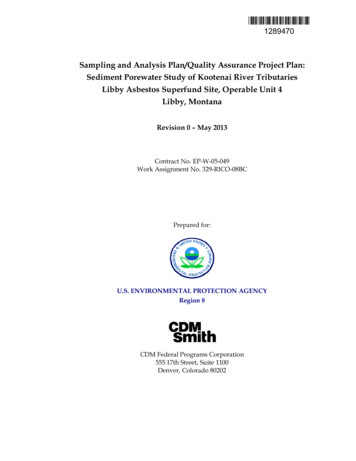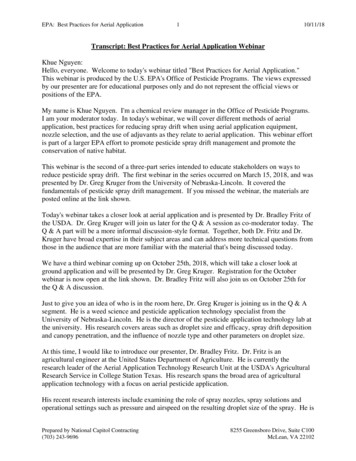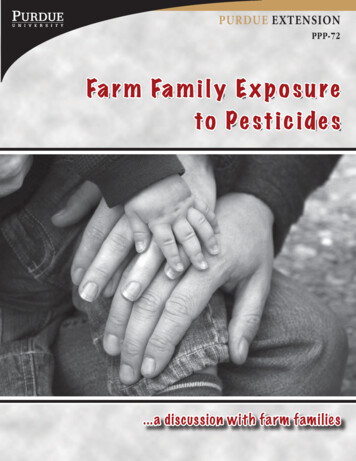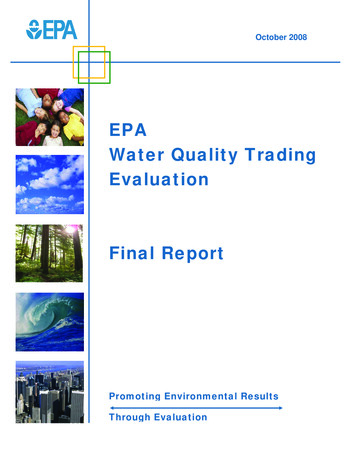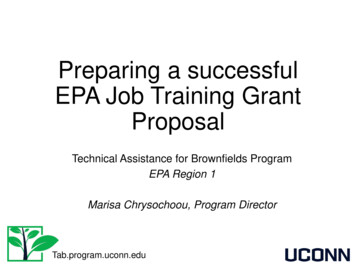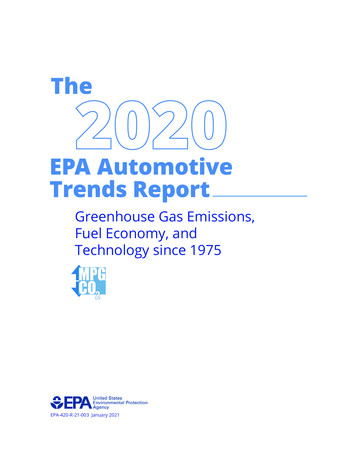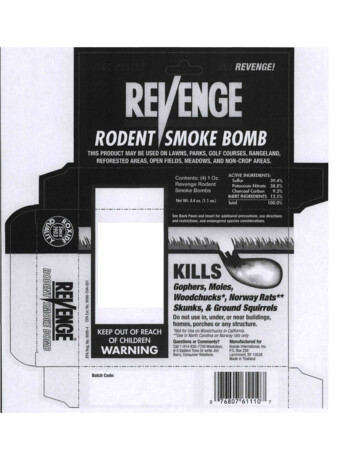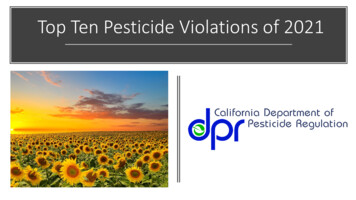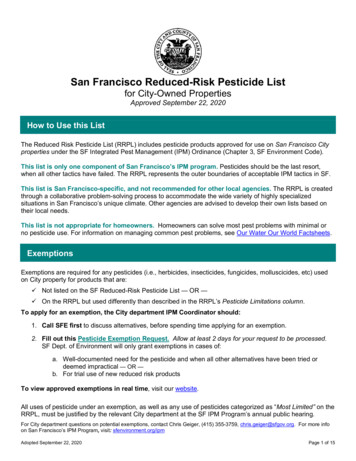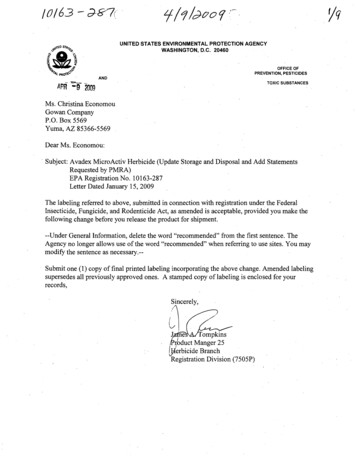
Transcription
/0/63 -d 7(UNITED STATES ENVIRONMENTAL PROTECTION AGENCYWASHINGTON, D.C. 20460OFFICE OFPREVENTION, PESTICIDESANDTOXIC SUBSTANCES., --.M'R -9 2009Ms. Christina EconomouGowan CompanyP.O. Box 5569Yuma, AZ 85366-5569Dear Ms. Economou:, Subject: Avadex MicroActiv Herbicide (Update Storage and Disposal and Add StatementsRequested by PMRA)EPA Registration No. 10163-287Letter Dated January 15, 2009The labeling referred to above, submitted in connection with registration under the FederalInsecticide, Fungicide, and Rodenticide Act, as amended is acceptable, provided you make thefollowing change before you release the product for shipment.--Under General Information, delete the word "recommended" from the first sentence. TheAgency no longer allows use of the word "recommended" when referring to use sites. You maymodify the sentence as necessary.-Submit one (1) copy of final printed labeling incorporating the above change. Amended labelingsupersedes all previously approved ones. A stamped copy of labeling is enclosed for yourrecords,cY lY' ,o---. J :eTompkinsrbduct Manger 25(yierbicide BranchRegistration Division (7505P)
@IMPORTANT NOTICEACfL; ;PTEDwlitllR C4lTh1IMEN]'Si[ii This product is registered in both the U.S. and Canada. It has rurrJ:I U.S. and Canada Labeling.You must follow ONLY the U.S. label WHEN USING THIS product in the U.S.You must follow ONLY the Canadian label WHEN USING THIS product in Canada.E)PA 1P J[)Sllt{oo:.'A!-'Ii - LDlJ9Avadex Unue ilM Fedm:all bseo S;:A e F'U.ngicl e, aa RcdeB;i ilct !loS sm.OO'rll . for ahe: polsn.ic!&eregistei'c(J :r EPA Reg. No M--'J1iJ!l;: . . .GROUPII HERBICIDE]croActiv.--.,HerbicideGranular Herbicide for Fall or Spring Treatment in Conventional and Direct Seeding Systems to Control Wild Oats in labeled crops. See the appropriate U.S. or Canadian Use Directions.AGRICULTURALACTIVE INGREDIENTS/GUARANTEETriallate, S-(2,3,3-1richloroallyl)-diisopropylthiocarbamate ,"OTHER INGREDIENTS:PRECAUnONARY STATEMENTSHAZARDS TO HUMANS AND DOMEsnc ANIMALS% By WI.KEEP OUT OF REACH OF CHILDREN10,0%90,0%ATIENTION, contains the allergen soy,CAUTION,TOTAL 100,0%Causes skin and eye irritation. Avoid contact with skin. eyes or clothing, Wash thoroughly with soap and water after handling, Prolongedor frequenUy repeated skin contact may cause allergic reactions in some individuals, Do not take Intemally. Refer to country specificlabel booklet for additional precautionsCAUTIONSTORAGE AND DISPOSAL IN THE U.S.Do not contaminate water, foodstuffs, feed or seed by storege and disposal.PESnCIDE STORAGE: Keep bag closed to prevent spills and contamination,PESnCIDE DISPOSAL: Wastes resulting from the use of this product that cannot be used or chemically reprocessed should bedisposed of in a landfill approved for pesticide disposal or in accordance with applicable Federal, state or local procedures.CONTAINER DISPOSAL: Nonrefillable container, Do not reuse or refill this container, Emptied container retains vapor and productresidue. Observe all labeled safeguards until ,container Is cleaned, reconditioned or destroyed, Completely empty container intotransfer or application eqUipment Offer for recycling, if available, or dispose of empty sack in a sanitary landfill or by incineration,or, if allowed by state and local authorities, by burning. If bumed, stay out of smoke.For Multlwall Bags: Nonrefillable container, Do not reuse or refill this container. Completely empty container into applicationequipment Offer for recycling if available, or dispose of empty container in a sanitary landfill or by incineration, or, if allowed bystate and local authOrities, by burning, If burned, stay out of smOke.READ THE ENTIRE LABEL BEFORE USING THIS PRODUCT. Use only according to label instructions, Read "NOTICE OF CONDITIONSOF SALE AND WARRANTY LIABILITY LIMITATIONS" before buying or using. If terms are not acceptable, retum at once unopened@FIRST AIDHerbicideIf swallowedCall a poison control center or doctor Immediately for treatment advice. Have person Sip a glass ofwater if able to swallow. Do not induce vomiting unless told to do so by a polson control center ordoctor, Do not oive anvthino by mouth to an unconscious person.If on skin or clolhlngTake off contaminated clothing. Rinse skin immediately with plenty of water for 15-20 minutes, Cal;'apoison control center or doctor for treatment advice,If In eyesHold eye open and rinse slowly and gentiy with water for 15-20 minutes. Remove contact lenses, ifpresent, after the first 5 minutes, then continue rinsing, Call a poison control center or doctor for treatment advice,STORAGE AND DISPOSAL IN CANADASTORAGE: Keep Avadex MicroActiv herbicide bag closed to prevent spills and contamination,Avoid contamination of seed. feed and foodstuffs,DISPOSAL: Do not reuse this container for any purpose, Thoroughly emply the contents of the container into the application device.Make the empty container unsuitable for further use, Dispose of the container in accordance with provinCial requirements,For information on the disposal of unused, unwanted product, contact the manufacturer or the Provincial Regulatory Agency, Contactthe manufacturer and the Provincial Regulatory agency in case of a spill, and for clean-up spills.HOT LINE NUMBERWhen seeking medical attention, take the container label If at all possible. If not, take information which identifies the product, thatis, the product names and registration numbers. You may also contact 1-888-478-0798 for emergency medical treatment inform a';nnTOXICOLOGICAL INFORMATION: Treat symptomatically,United Siaies AGRICULTURAL USE REQUIREMENTSUse this product only in accordance with its labeling and with the Worker Protection Standard, 40CFR Part 170. Refer to supplementallabeling under "Agricultural Use Requirements: in the Directions for Use section focinformation ab '!:t!!is standard,Ib;::::-, ENVIRONMENTAL HAZA ".l! r " "(' rOo n ti!p ly directlfto water. to areas where surface water is present, or to in'"rtidaLare.,sbelcw the'''' ?n high water mark. Do not"C'co:.tamin:"te wat r fhen cleaning equipment or disposing of equipment wash" ters Sr rir:sate. efer to ccCJntry specific label booklet(\ c . r. fO,"'ddditicnal enviro.'1mental hazard Information.('" . r- C , . ., ,.,"r r'7" )("0('C''"('r r-No.- "In Ihe Unlled Siales: It is a violation of United States law to use this product without having obtained the United States label at thetime of purchase and following the'U.S, label at the time of application.In Canada: NOTICE TO USER: This pest control product is to be used only in accordance with the directions on the label. It is anoffense under the Pest Control Products Act to use this product in a way that is inconsistent with the directions on the label. The userassumes the lisk to persons or property that arises from any such use of this product. 'NET CONTENTS 995 Ibs./451.3 kgs- r r rEPA Est. No. 070989-IA-001(' ,egi&.r tiJn No, '::! M2 PEST CONTROL PRODUCTS lr:!r "EfARr;.;l. No: 101,.,3-287 r A"MA- J5-R('408 - - "crli;;m45790 C''@- .,(' yan ,Go'filll.CANADAThe Go To Company@Produced For:Gowan CompanyP.O. Box 5569Yuma. AZ 85366-5569 U.S.A.(800) 883 1844
(U.S. LABELIt is a violation of United States law to use this product in the United States in a manner inconsistent with its United States labeling.Avadex MicroActivHerbicideGranular selective herbicide for fall or spring application to control wild oats in winter wheat, spring and durum wheat, barley,triticale, peas (green, field dried, chickpeas, garbanzo beans), lentils, and sugar beet; and for fall application to suppress Bromusspecies (B. tectorum, B. secalinus and B. japonicus) in winter wheat and in winter barley.For use in California·, Colorado, Idaho, Kansas, Minnesota, Montana, Nebraska, Nevada, North Dakota, Oregon, South Dakota,Utah,.Washington, and Wyoming. Not for use on sugar beets in California.ACCEPTED.:!!]!"""' TJ,;;mHI)'i:'-i'J"""'"vv .lit",,- 'U\Ull'liE.l'i'.IUi!, '\i 11 c'.I ll1EPA Letjer D.mt e tAPR - 9' 2009AC.TIVE INGREDIE T:. .% By t. .Tnallate, S-(2,3,3-tnchloroallyl)-dllsopropylthlocarbamate . 10.0 YoOTHER INGREDIENTS: .V.ndflr.!! MlEn· "': .Jb.,.".jc.u,, . 90.0%. F .; e;6.;lill';':tO;AL 100.0%.Attention, contains the allergen soy.KEEP OUT OF REACH OFas 1!ll'Jl!: .M. §' l!." fth", 5'ei:J r.:!l!k w rf &'% iP'if.' ; i:!;",.CHllDREN i. -CAUTIONRead the entire label before using this product. Use only according to label instructions. Read "NOTICE OF CONDITIONS OF SALE ANDWARRANTY LIABILITY LIMITATIONS" before buying or using. Ifterms are not acceptable, return at once unopened.THIS IS AN END-USE PRODUCT. GOWAN COMPANY DOES NOT INTEND AND HAS NOT REGISTERED IT FOR REFORMULATION. SEEINDIVIDUAL CONTAINER LABEL FOR REPACKAGING LIMITATIONS.FIRST AIDHerbicideIf swallowed Call a poison control center or doctor immediately for treatment advice. Have person sip a glass of water if able to swallow. Do not induce vomiting unless told to do so by a poison control center or doctor. Do not giveanything by mouth to an unconscious person.If on skin or clothing Take off contaminated clothing. Rinse skin immediately with plenty of water for 15-20 minutes.If in eyesc Call a poison control center or doctor for treatment advice. Remove contact lenses, if present, after the first 5 minutes, then '.:a,ti,'·J0 rinsin .' ,(Hold eye open and rinse slowly and gently with water for'15-20 minutes.,Call a poison control center or doctor for treatment advice.HOT LINE NUMBER((((-(C (',"((((( ( ( {. ( C'(lf.( C t((When seeking medical attention, take the container label if at all possible. If not, take information which identifieS the product, that is, the. product names and registration numbers. You may also contact 1-888-478-0798 for emergency medical treatw I!!j formatic:; -c {((((.(' «(((NET CONTENTSEPA Reg. No. 10163-287EPA Est. No. 070989-IA-001lt.'(lI ( l L Go'fCllITheGo To Company(. I.Produced For:Gowan CompanyP.O. Box 5569Yuma, AZ. 85366-5569
'I/r('PRECAUTIONARY STATEMENTSHAZARDS TO HUMANS AND DOMESTIC ANIMALSCAUTIONCauses Moderate Eye Irritation. Avoid contact with skin, eyes or clothing. Wash thoroughly with soap and water after handling. Prolonged orfrequently repeated skin contact may cause allergic reactions in some individuals. Refer to country speCific label booklet for additionalprecautions.PERSONAL PROTECTIVE EQUIPMENT (PPE)Loaders, applicators*, f1aggers* and other handlers must wear: Long-sleeved shirt and long pants, shoes plus socks.A NIOSH approved particulate filtering respirator equipped with N, R, or P class filter media. The respirator should have a NIOSH approvalnumber prefix TC-84A.* See engineering controls below for additional requirements . Follow manufacturer's instructions for cleaning/maintaining PPE. If no such instructions for washables exist, use detergent and hot water.Keep and wash PPE separately from other laundry.USER SAFETY RECOMMENDATIONSUsers should:Wash hands before eating, drinking, chewing gum, using tobacco, or using the toilet.Remove clothing/PPE immediately if pesticide gets inside. Then wash thoroughly and put on clean clothing.Remove PPE immediately after handling this product. Wash the outside of gloves before removing. As soon as possible, washthoroughly and change into clean clothing.ENGINEERING CONTROLSPilots must use an enclosed cockpit that meets the requirements listed in the Worker Protection Standard (WPS) for Agricultural Pesticides [40CFR 170.240(d)(6)].Flaggers must be in an enclosed cab that meets the definition in the Worker Protection Standard for Agricultural Pesticides for dermalprotection and in addition to wearing the required PPE specified above, have immediately available for use in case they must leave the cab:coveralls, chemical-resistant gloves and Chemical-resistant footwear, such as nitrile rubber, neoprene, neoprene rubber, or polyethylene.ENVIRONMENTAL HAZARDSDo not apply directly to water, to areas where surface water is present, or to intertidal areas below the mean high water mark. Do notcontaminate water when cleaning equipment or disposing of equipment washwaters or rinsate. Refer to country speCific label booklet foradditional environmental hazard information.Ground Water AdviSOryTriallate has a, degradation, product TCPSA (trichloropropene sulfonic acid) with properties and characteristics associated with chemicalsdetected in ground water. The use of this chemical in areas where soils are permeable, particularly where the water table is shallow, mayresult in ground water contamination,Surface Water AdvisoryUnder some conditions, the triallate degradate TCPSA may have a high potential for runoff into surface water (primarily via dissolution inrunoff water). These include poorly draining or wet soils with readily visible slopes toward adjacent surface waters, frequently flooded areas,areas over-laying extremely shallow ground water, areas with in-field canals or ditches that drain to surface water, areas not s R fated fromadjacent surface waters with vegetated filter strips, and areas over-laying tile drainage systems that drain surface water.f(t{(rDIRECTIONS FOR USE,, (It is a violation of Federal law to use this product in a manner inconsistent with its labeling,Th'is product can only be used in accordance with the Directions for, Use on this label or in separate'y ' llrli hed ?o "'.'iI" Company( ,Supplemental Labeling, '(\Ct. I I(,l.(.Do not allow this product to drift. Do not apply this product in a way that will contact workers or other persons,' fithecdirectly 6r through drift.Only protected handlers may be in the area during application. For any requirement specific to your Stat3 ere Tribe, consult'the agencyresponsible ,for pesticide regulation,' ( , '.(. l., («I,t.«l
(AGRICULTURAL USE REQUIREMENTSUse this product only in accordance with its labeling and with the Worker Protection Standard, 40 CFR part 170. This ,Standard containsrequirements for the protection of agricultural workers on farms, forests, nurseries, and greenhouses, and handlers of agricultural pest.icides. Itcontains requirements for training, decontamination, notification and emergency assistance. It also contains specific instructions andexceptions pertaining to the statements on this label about personal protective equipment (PPE) and restricted-entry interval. The'requirements in this box only apply to uses of this product that are covered by the Worker Protection Standard.Do not enter or allow others to enter the treated area (except thqse persons involved in the incorporation) until the incorporation is completefollowing application . Do not enter or allow worker entry into treated areas during the restricted-entry interval (REI) of 12 hours. Exception: if the product is soilinjected or soil-incorporated, the Worker Protection Standard, under certain circumstances, allows workers to enter the treated area if therewill be no contact with anything that has been treated.PPE. required for early entry to treated areas that is permitted under the Worker Protection Standard and that involves contact with anythingthat has been treated, such as plants, soil, or water, is: Coveralls Shoes plus socks Chemical-resistant gloves, such as nitrile rubber, neoprene rubber or polyethylene.For more options, follow the instructions for category A (dry and water-based formulations) on an EPA chemical-resistant category selectionchart.GENERAL INFORMATIONThis herbicide is recommended for wild oat control in barley, peas (green, field dried, chickpeas, garbanzo beans), lentils, durum, spring andwinter wheat, triticale, and sugar beet only, and for suppression of downy brome (Bromus tectorum), cheat (Bromus secalinus) and Japanesebrome (Bromus japonicus) in winter wheat and winter barley. Other crops should not be treated with this product because injury may occur.For barley, durum, spring wheat, triticale and sugar beet, this product may be applied on the soil either in the fall or in the spring before wildoats germinate. For lentils and peas, this product may only be applied in the spring before wild oats germinate. For winter wheat, this productmay only be applied in the fall before wild oats germinate.Application eqUipment must be properly calibrated: application of too much herbic!de may injure the crop; application of too little may result inpoor wild oat control. Specified' rates must be followed in order to:1.Avoid crop injury2.Avoid crop residue at harvest -3.Control wild oats4.Suppress Bromus speciesGENERAL PRECAUTIONS AND RESTRICTIONSApplication to a field which is wet, lumpy, rough or ridged will result in reduced wild oat control and promote crop thinning. Incorporation must becompleted within 48- hours after application and before germination of the wild oats. If weeds, including wild oats, have emerged prior to treatingand/or planting, they must be controlled. All deep tillage by cultivators or double disc implements must be completed prior to application, Do not plow' 'following application of this herbicide.r,Seeding may be done either before or after application, depending upon the crop that is to be sown. If seediQ9. i ,d,eLayed, s,;,(;'I;.:).- faworkingof the treated area before seeding will not destroy the effects of the chemical.( ,'((When using this herbicide, a strip should be left untreated for proof of results. Weed control may be evaluated(a'I(I)(O)' removil'" i:t uiiace inchor two inches of the soil at the time of germination to inspect the number of wild oats that were killed before emerg'Etn.r:e.l' ( (( ( . ( .,L(.((Wild oats are usually killed before emergence, but occasionally, and particularly under dry conditions, plants may [each the 3,4 leaf stagebefore they die.'l ( ( ,; r, l , (( { t. (Under conditions of prolonged high temperature at the time of germination, or extreme drought in the spring, this product may notrr.aintain theusual high standard of wild oat control.' , ( .' , l (ATTENTIONDELAYED EMERGENCE, STAND REDUCTION, STUNTING AND YIELD LOSS MAY RESULT DUE TO COLD OR WET CONDITIONS,IRRIGATION DURING GERMINATION OR EMERGENCE, DEEP PLANTING, SOIL CRUSTING, DISEASE, INSECTS, OR SELECTION OFA VARIETY GENETICALLY SUSCEPTIBLE TO STRESS. THESE ARE CONDITIONS BEYOND THE CONTROL OF GOWAN COMPANY,
(AND THE GROWER SHOULD CONSULT THE STATE UNIVERSITY EXTENSION SPECIALIST OR SEED PRODUCER OR SUPPLIERFOR LOCAL VARIETAL INFORMATION AND RECOMMENDED TILLAGE AND PLANTING PRACTICES AND DATES.LATE PLANTING OF WINTER WHEAT OR PLANTING WINTER WHEAT UNDER UNFAVORABLE ENVIRONMENTAL CONDITIONS THATRESULT IN FAILURE OF THE WHEAT TO EMERGE IN THE FALL MAY RESULT IN STAND REDUCTION, STUNTING AND YIELD LOSS.Domestic oats should not be seeded where. this product was used the previous year.Do not rotate to crops othe(than winter wheat, spring and durum wheat, triticale, barley, peas (green, field dried, chickpeas, and garbanzobeans), lentils, and sugar beets for 12 months after an Avade MicroActiv Herbicide application.Do not graze livestock· on treated crops.When this product is used on clay knobs, crop thinning may occur due to uneven .seeding depth and poor crop establishment conditions.Thinning is usually offset by increased tillering and by the reduction of wild oat competition.IN THE STATE OF MONTANA, do not use this product on fields to be seeded to hard red spring wheat with press drills, if the field is or will beirrigated in the current growing season.Do not use post-plant incorporation with hoe drills. This practice will result in unacceptable seeding depth and an excessive concentration ofthis product in the seed zone.Use of this product not consistent with this label may result in injury to persons, animals or crops, or other unintended consequences. Keepcontainer closed to prevent spills and contamination.APPLICATION EQUIPMENT AND TECHNIQUESThis product must be applied through a specially designed ground applicator or airplane capable of applying small quantities of granulese enly.Application is limited to one per growing season and must not exceed 15 pounds of Avade MicroActiv Herbicide per acre.GROUND EQUIPMENT:It is important that the applicator be calibrated properly to deliver the desired amount of this product to avoid applying too little, or too much,material. To give even distribution, scatter plates (similar to those us d for applying granules in a band) must be attached to each delivery tubeor outlet in such a manner to give overall coverage. To calibrate, attach a collector pan, or bag, over each spreader plate or delivery tube.Operate over normal terrain to be treated at 4 to 5 miles per hour. Collect the granules from all outputs after covering the desired distance.For example: If a 14-foot applicator is being used, stake off a distance of 324 feet in the field to be treated (distance equal to 1/10 acretreated}. After attaching a bag or a collection pan to each outlet, collect the granules while driving the desired distance. Check to see that eachoutlet disperses the same amount of granules. Combine all samples and weigh. For the above set of conditions, the quantity of granules thatshould be collected for the following recommended rates of broadcast treatment are:APPLICATION RATES PER ACRE101bs.12.5Ibs.151bs.1 lb.1.25Ibs.1.5Ibs.{l(,{Amount to be collected:((((.((,(I(f { (.If more or less than the desired quantity is collected, adjust accordingly and again collect the granules while driv::ng the staked-,')ff distance.Continue this procedure until the required amount is delivered.Ll(It ( { ( ,llC(.,'.I. . \. (.AIRPLANE: For aerial application, attachments designed for applying low volumes of granules must be used. In orJ6r to ens\!,ri:! u .lii rm aerialapplication, it is recommended that the field distribution pattern is checked and any necessary gate and vent m6d, fici:it!ons are I nade o ensurean even pattern distribution. In order to ensure uniform application and to avoid overlapping and possible crol').)[lj JrY: it is recominended thattwo f1aggers, one at each end of the field, be used.( tel( C ( (FIELD PREPARATION (' ( lBefore applying this product, be sure the soil is in good working condition. All deep tillage by cultivation, or double disc implements, must becompleted prior to application of this product. If stubble ground is being treated, one or two passes with a field cultivator may be requiredbefore application and incorporation.
(INCORPORATED APPLICATIONSWhen summer fallow or plowed ground is being treated, a field cultivator will provide adequate incorporation. For proper incorporation of thisproduct, set incorporation implement to work the soil no deeper than 3 to 4 inches. Do not use disc implements for incorporation.FALL - On summer fallow ground which is loose arid free of lumps and trash, incorporate this product using equipment similar to a cultiharrow or a duck-foot with rod weeder attachment.For applications to fields or standing stubble, fields may be worked once or twice with a. field cultivator or chisel plow. Apply granules andincorporate with a field cultivator or culti-harrow.If soil must be ridged after incorporating to prevent soil erosion by high winds, the depth of ridging should be kept to a minimum.In preparing the herbicide-treated area for seeding in the spring, care must be taken to avoid working the soil any deeper than fall tillage.When incorporating with a single pass in the fall, a second incorporation must be performed in the spring during seedbed preparation. If nospring work is anticipated, then both incorporations shou'ld be done in the fall.For applications to winter wheat after seeding, apply and shallowly incorporate with a spike tooth, or spring tooth harrow set shallowly as not todisturb wheat seed.SPRING - Before Seeding Incorporation: Fpr applications to fields of standing stubble, work fields once or twice with a disc, field cultivatoror chisel plow, to provide soil in a good working condition. Apply granules and incorporate with equipment such as a culti-harrow or duck-footcultivator. A second incorporation at right angles should provide best results. A delay of at least 3 days between the first and secondincorporation is recommended for optimum performance.c.FOR SPRING AND DURUM WHEAT AND BARLEY IN MONTANA ONLY - For suppression of Persian darnel (Lolium temulentum), apply thisproduct before seeding and shallowly incorporate.After Seeding Incorporation: Apply granules immediately after seeding and shallowly incorporate at right a-ngles with equipment such as aflex multi-weeder or harrow. Adjust incorporation equipment to a depth so as not to disturb the seed.FALL TREATMENT INCORPORATEDCROPSpring and Durum Wheat, and BarleyWinter Wheat and Winter Barley**tSugar beet (Except CA)RATE (Ib/A)12.5 to 1512.5to 1515WHEN TO APPLY*Within 3 weeks of normal freeze-up, or until snow cover occurs.Before or after seeding.Fall application - within three weeks of normal freeze-up or until snow coveroccurs.Apply lower rates on light soils and apply higher rates on heavy soils.Incorporate within 48 hours. For methods, see "FIELD PREPARATION" and "INCORPORATED APPLICATIONS" sections of this label.Breakdown of this product is minimal at soil temperatures of 40 F or less.For suppression of downy brome (Bromus tectorum), cheat (Bromus secalinus) and Japanese brome (Bromus japonicus) apply 15pounds per acre prior to planting and shallowly incorporate. In Colorado, Kansas, Nebraska and South Dakota plant with hoedrills only.especially on clay knobs, where seed is "dusted in" or "floatedtFor winterwheat in the Pacific Northwest, some crop thinning may occur,.on" and emergence is delayed. Thinning is usually more than offset by tillering and increased yields.' «.CROPSpring and Durum WheatSpring and Durum WheatSpring and Durum WheatBarley and TriticaleSPRING TREATMENT INCORPORATED,RATE (Ibs/A)WHEN TO APPLY 10to 12.5After seeding before wild oats germinate.(. ( \, "\t. ll1010 to 12.5(Before seeding and before wild oats germinate - DisC/Pie5 Urills.Before seeding and before wild oats germinate -,(HObc;(FI .((,(\,((((ll(('-(((Just before or immediately after seeding, before wild ,,-is--Siarminate. c c ,- 12.5 to 15Just before or immediately after seeding, before wild oats germinate., , , -, (12.5 to 15LentilsJust before or immediately after seeding, before wild oats germinate,.12.5 to 15Peas (green, field dried,, ,. ( , ,chickpeas, garbanzo beans)l L t,. i.15. Before seeding and before wild oats germinate.Sugar beet (Except CA)*Apply lower rates on light sOils and apply higher rates on heavy sOils.Incorporate within 48 hours. For methods, see "FIELD PREPARATION" and "INCORPORATED APPLICATIONS" sections of this label.Best spring and durum wheat results will be obtained with at least a 3-day delay between herbicide incorporation and seeding.
(SURFACE APPLICATION WITH DELAYED INCORPORATION USE ONLY IN CALIFORNIA,IDAHO, MINNESOTA, MONTANA,NORTH DAKOTA AND UTAHThis product may be applied as a surface application with a delayed incorporation prior to planting spring wheat, durum wheat, and barley at arate of 15 pounds per acre for all soil types.Surface applications of this product which will be follow d by a delayed incorporation in the spring may be made beginning 3 weeks prior tosoil freeze-up in the fall and ending before spring thaw. (Average soil temperature at the 2-inch depth must be 40 F or less).Surface applications must be incorporated in the spring; two passes are recommended. If surface applications are made because soilconditions do not permit incorporation and these conditions change, making incorporation possible, incorporate even if several weeks afterapplication.This surface application may be made in standing stubble or to fields with surface residues. Surface applications should nolbe made to fieldscovered with snow or with excessive crop residue, which will not allow granule contact with the soil.Surface applications with delayed incorporation may not provide the same level of wild oat control as fall incorporated applications. Wild oatcontrol resulting from delayed incorporation may be reduced if drought or abnormally warm temperatures occur between application and cropemergence in the spring. To achieve the most reliable wild oat control, this product should be incorporated within 48 hours of application asdescribed in the "FIELD PREPARATIONS" and "INCORPORATED APPLICATIONS" sections of this label.NO-TILL APPLICATIONFOR WILD OAT CONTROL IN SPRING PLANTED CROPSThis product may be applied prior to planting no-till spring wheat, durum wheat, and barley at a rate of 15 pounds per acre for all soil types.For best results no-till applications of this product may be made 3 weeks prior to soil freeze-up and ending before spring thaw (average soiltemperature at the 2-inch depth must be 40 F or less). Spring applications can also be made if applications are made at least 10 to 14 daysprior to seeding.No-till applications may be made in standing stubble or to fields with surface residue. No-tillwhich will not allow granule contact with the soil.a plicationsshould not be made under conditionsNo-till applications are to be made in reduced tillage/no-till systems only. Best results should be expected when utilizing drills equipped withhigh disturbance openers. When seeding with drills equipped with low disturbance openers, or with spring applications, use of heavy harrowsor similar minimal disturbance implements prior to seeding may improve control. It is recommended that seeding be delayed until fields beginto green up in the spring and an application of a glyphostite herbicide has been made to control emerged
In Canada: NOTICE TO USER: This pest control product is to be used only in accordance with the directions on the label. It is an offense under the Pest Control Products Act to use this product in a way that is inconsistent with directions on label. The user assumes the lisk to persons or property that arises from any such use of this product.
